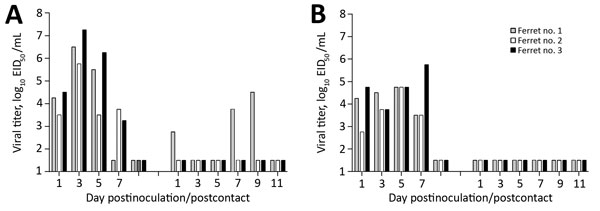Volume 24, Number 1—January 2018
Dispatch
Mammalian Pathogenesis and Transmission of Avian Influenza A(H7N9) Viruses, Tennessee, USA, 2017
Figure 1

Figure 1. Transmission of avian influenza A(H7N9) virus ck/TN between ferrets in direct contact, Tennessee, USA, 2017. Three ferrets were inoculated with 106 EID50 of A) low pathogenicity avian influenza virus or B) highly pathogenic avian influenza virus, and nasal washes were collected from each ferret on the indicated days postinoculation (left bars) to assess viral replication. An immunologically naive ferret was placed in the same cage as each inoculated ferret at 24 h postinoculation, and nasal washes were collected from each contact ferret on the indicated days postcontact. Bars indicate individual ferrets. All ferrets were serologically negative for circulating influenza viruses at the start of the study. The limit of virus detection was 101.5 EID50/mL. EID50, 50% egg infectious dose.